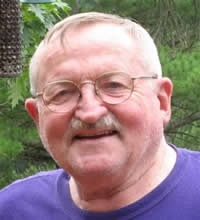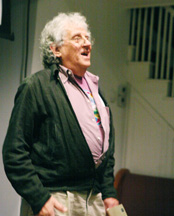July 10, 2018
Long-time Linnaean Society member Richard Bentley (1931–2018) passed away on November 26th, 2018. He was a Greenwich Village resident and devoted much of his retirement time to observing the birds that showed up in the gardens of St. Luke’s church. He recorded these sightings in the piece that follows.
Birds in Our Gardens
Early in my retirement I decided to explore the bird population in the gardens at St. Luke’s. I wasn’t expecting too much compared to my regular routine of birding the more well-known spots in the city such as Central and Prospect Parks, and Jamaica Bay Wildlife Refuge. It was a thrill to discover that our gardens were a small but important way station for migratory birds in spring and fall.
My daily visits with binoculars in hand helped me to make friends with Debbie Peterson, the St. Luke’s gardener at that time. She encouraged me not only as a garden volunteer, but also suggested that a log of the birds being spotted be maintained so that others might appreciate this aspect of the gardens. This turned out to be a most enjoyable project for me.
My first surprise came when I spotted a northern waterthrush, a small ground foraging warbler of swamps and wetlands. Another day while sitting under the shade of a crabapple tree, I looked up, and not three feet overhead was a yellow-billed cuckoo with its long scalloped-patterned tail. On this same day a house wren was running up and down the vines on the side of a building, and an ovenbird strolled in and out of the bushes, while a tiger swallowtail butterfly danced above. The listing in the garden log was off to an auspicious start!
My regular forays into the gardens have given me the opportunity to meet new and old birding friends, painters, photographers, and other nature lovers. I fondly recall meeting an associate of Debbie who was touring with a garden club. It impressed me when he recorded the first sighting of a hummingbird in the gardens. I was even more impressed in a long conversation to learn that he was an orchid expert as well as a well-known birder and an acquaintance of Roger Tory Peterson, the famous author of many field guides.
It would be tedious to list all the birds that have been seen in the gardens, but a few encounters might capture the natural treasure we share on the block at St. Luke’s. Like the time two peregrine falcons were squabbling directly overhead; or when I was startled by a woodcock suddenly flushing up in front of me; or watching a hooded warbler in its contrasting yellow face and black hood flitting about the fence in the rectory garden; or the early morning view of three Baltimore orioles and an unusual orchard oriole feeding feverishly in one of the apple trees; or sitting on a bench listening to the peenting of nighthawks diving in the twilight sky of a summer evening while fireflies flickered all over the south lawn. Then there was the startling color of a scarlet tanager perched on a cluster of peonies. Finally, there was the thrill this last fall, when I saw my first Connecticut warbler in New York, skulking around the statue of Mary in the school yard. (Unfortunately, Patches, the thrift shop cat, must have spotted it first, because the bird had lost its tail.)
The list of birds could go on indefinitely. At last count there were 94 species recorded in the log since the fall of 1992. The list includes our resident mockingbirds who regularly serenade or scold us to defend their territory. The log goes on to include twenty-three warbler species—ten different sparrows—five species of thrush—four kinds of vireos—three woodpeckers—two kinglets—but a pear tree without a partridge!
This spectacle of nature does not stop with birds, but includes twenty-four species of butterflies; the hummingbird and Nessus sphinx moths; eight different dragonflies; and myriad other insects to pique the interest of the nature lover.
Last of all I cannot forget that it was my love of birds in particular and nature in general that led me into the community of St. Luke’s where I feel spiritually at home with a proprietary interest in the gardens.
by Richard Bentley
March 23, 1999




